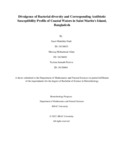Divulgence of bacterial diversity and corresponding antibiotic susceptibility profile of coastal waters in Saint Martin's Island, Bangladesh
Abstract
Considered to be the largest reservoir of microorganisms, ocean water holds massive potential for scientific research. The Saint Martin’s Islands of Bangladesh, located in the north-east part of the Bay of Bengal, is one such reservoir with very limited study having been conducted on its biodiversity. Moreover, the island is a popular tourist destination, so it often faces overpopulation. Hence, it has become a potential home for a diverse culture of bacteria. The purpose of this study was to identify the bacterial diversity of the coastal waters in Saint Martin’s Island and to determine the corresponding antibiotic effectiveness profile. The main concern was to identify whether or not the bacterial presence in the island’s water could become a public health concern. The samples were collected and analyzed through biochemical testing, antibiotic susceptibility testing, PCR, and gel electrophoresis. The results showed that the marine water stores a significant number of bacteria belonging to the Enterobacteriaceae, Bacillaceae, Staphylococcaceae and Vibrionaceae families. Furthermore, at lesser majorities, different species belonging to the Yersiniaceae, Paenibacillaceae, Brevibacteriaceae, Aeromonadaceae, and Morganellaceae families were also identified. The characteristics of the identities pointed to be mostly rod-shaped (70%) and tested type Gram negative (59.4%). Altogether, 100% of the identifications were tested catalase positive which indicated aerobic nature. Subsequent antibiotic susceptibility profiling yielded in 97.8% effectiveness by Amikacin, 95.7% for Meropenem, 89.4% for Norfloxacin, 85.1% for Amoxicillin + Clavulanic acid, 61.7% for Tetracycline, 57.4% for Azithromycin/Erythromycin, 46.8% for Amoxicillin, 44.6% for Colistin Sulphate, 34% for Vancomycin, and 31.9% for Cefixime. Following PCR runs resulted in the detection of mcr-1 gene presence in the Colistin Sulphate resistant isolates, justifying the compromised efficacy of the last-resort drug. To this regard, presence of disease causing, antibiotic resistant bacteria in coastal waters indicates declining water quality. This further demonstrates the increasing possibility of severe health risks being linked to interactions with the coastal region if nature is not given sufficient opportunities to heal on its own.

